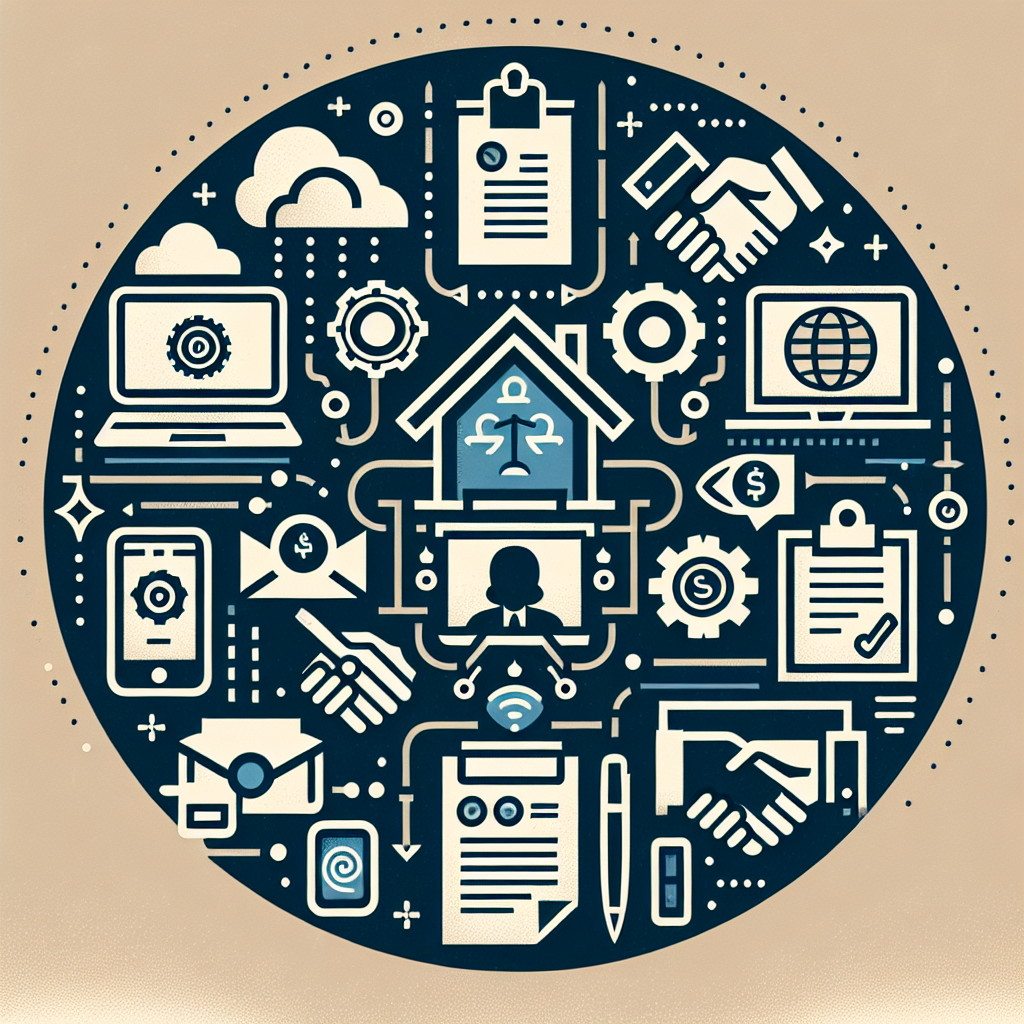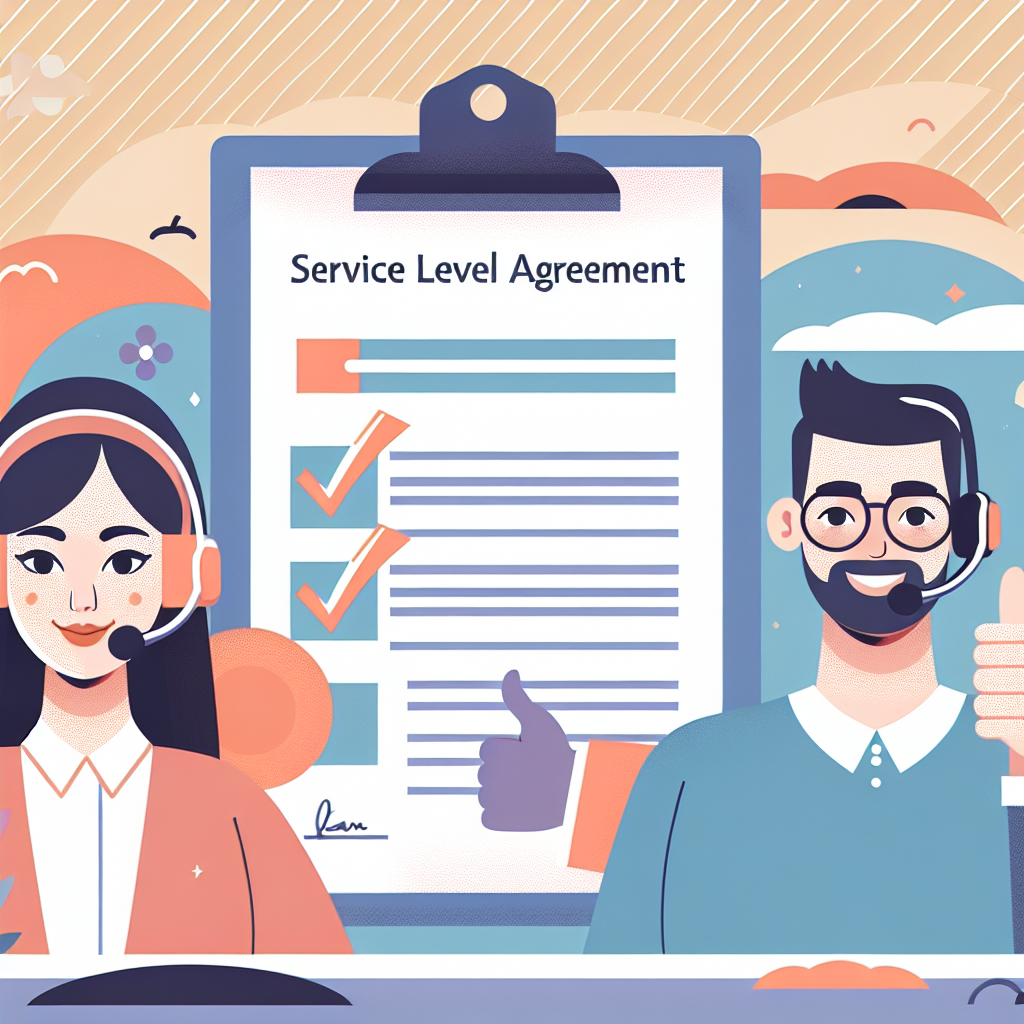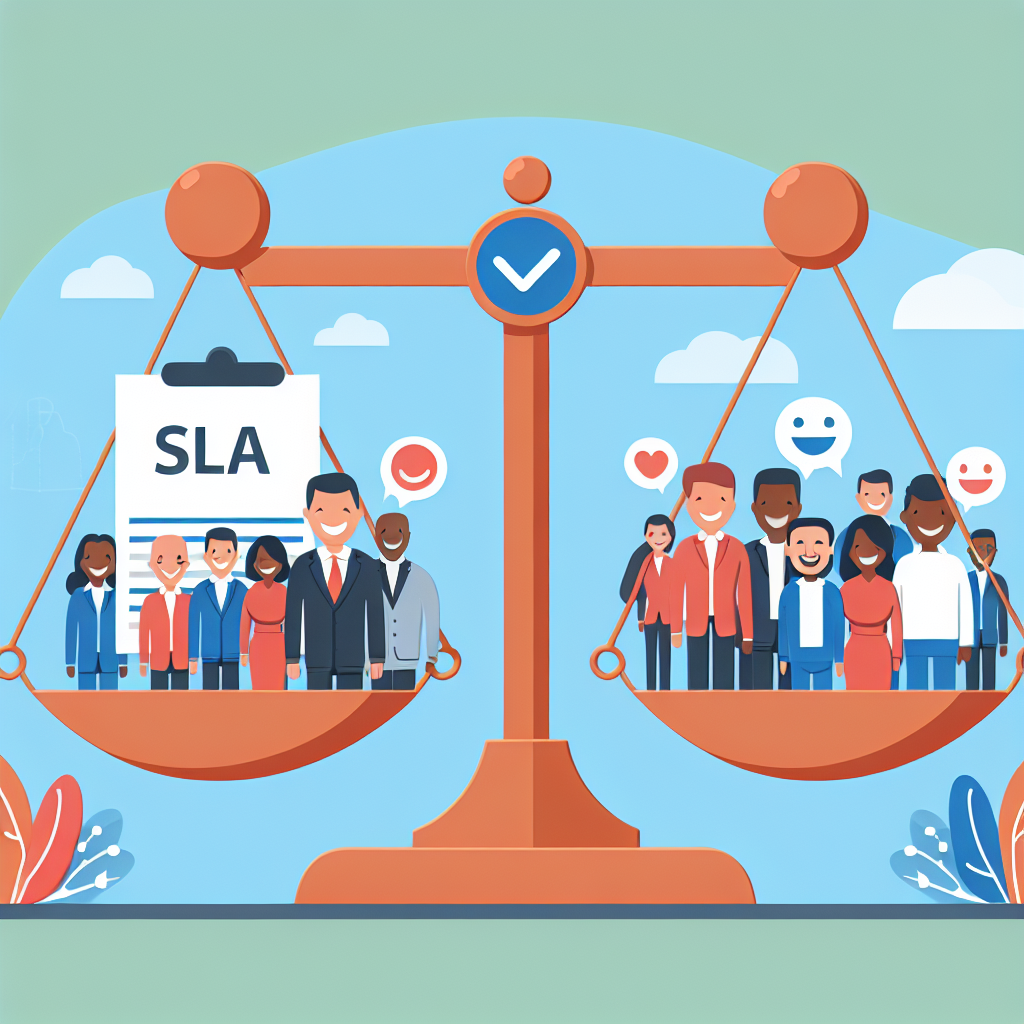Your cart is currently empty!
Tag: Agreements

Leveraging Service Level Agreements to Drive Business Growth and Success
Service level agreements (SLAs) are a crucial aspect of any business relationship, as they define the expectations and responsibilities of both parties. While SLAs are often seen as a way to ensure that service providers meet their obligations, they can also be leveraged by businesses to drive growth and success.One of the key benefits of a well-crafted SLA is that it can help align the goals of the service provider with those of the business. By clearly outlining the desired service levels, response times, and performance metrics, an SLA can ensure that the service provider is working towards the same objectives as the business. This alignment can drive better outcomes and ultimately lead to increased business growth.
Additionally, SLAs can help businesses hold service providers accountable for their performance. By including penalties for failing to meet agreed-upon service levels, businesses can ensure that their service providers are motivated to deliver high-quality service. This can result in improved efficiency, productivity, and customer satisfaction, all of which can contribute to business success.
Furthermore, SLAs can provide businesses with valuable data and insights that can be used to drive strategic decision-making. By tracking key performance indicators outlined in the SLA, businesses can identify areas for improvement and make informed decisions about resource allocation and process optimization. This data-driven approach can help businesses stay competitive and agile in a rapidly changing market.
In order to leverage SLAs effectively, businesses should ensure that they are well-defined, measurable, and regularly reviewed and updated. By establishing clear expectations and monitoring performance against agreed-upon metrics, businesses can maximize the value of their SLAs and drive business growth and success.
In conclusion, service level agreements are a powerful tool that businesses can use to drive growth and success. By aligning goals, holding service providers accountable, and using data to inform decision-making, businesses can leverage SLAs to drive better outcomes and ultimately achieve their business objectives. Investing time and resources in developing and managing SLAs can pay off in the form of improved efficiency, productivity, and customer satisfaction, leading to long-term business success.

Negotiating Service Level Agreements with Vendors: Tips and Best Practices
Negotiating service level agreements (SLAs) with vendors is a crucial aspect of any business relationship. An SLA is a formal contract between a vendor and a client that outlines the expected level of service, performance metrics, and responsibilities of each party. By setting clear expectations upfront, both parties can ensure a successful partnership and avoid any misunderstandings down the line.Here are some tips and best practices for negotiating SLAs with vendors:
1. Define your requirements: Before entering into negotiations with a vendor, it’s important to clearly define your requirements and expectations. This includes identifying key performance indicators (KPIs), service levels, and any specific deliverables that are important to your business. Having a clear understanding of what you need will help you negotiate more effectively and ensure that the SLA meets your needs.
2. Set realistic expectations: When negotiating SLAs, it’s important to set realistic expectations for both parties. Make sure that the service levels and performance metrics outlined in the SLA are achievable and in line with industry standards. Setting unrealistic expectations can lead to dissatisfaction and ultimately, a breakdown in the vendor-client relationship.
3. Include penalties and incentives: SLAs should include penalties for non-performance as well as incentives for exceeding performance targets. Penalties can help incentivize vendors to meet their obligations, while incentives can encourage them to go above and beyond to deliver exceptional service. By including these provisions in the SLA, both parties are motivated to meet or exceed expectations.
4. Establish clear communication channels: Effective communication is key to a successful vendor-client relationship. Make sure that the SLA includes provisions for regular communication, reporting, and issue resolution. Establish clear channels for communicating with the vendor, such as regular meetings or status updates, to ensure that both parties are on the same page.
5. Review and revise regularly: SLAs should not be set in stone. It’s important to regularly review and revise the SLA to ensure that it continues to meet the needs of both parties. As your business evolves and changes, so too should the SLA. By regularly reviewing and revising the SLA, you can ensure that it remains relevant and effective in guiding the vendor-client relationship.
In conclusion, negotiating service level agreements with vendors requires careful consideration and planning. By following these tips and best practices, you can ensure that your SLA is effective in setting clear expectations, incentivizing performance, and fostering a successful partnership with your vendors.

The Future of Service Level Agreements in a Digital Age
Service Level Agreements (SLAs) have long been a cornerstone of business relationships, outlining the level of service that can be expected from a provider. In the digital age, where technology is constantly evolving and businesses are increasingly reliant on digital services, the future of SLAs is being redefined.One of the key challenges facing SLAs in the digital age is the rapid pace of technological change. With new technologies emerging on a regular basis, it can be difficult for businesses to keep up with the latest developments and ensure that their SLAs are up to date. This has led to a shift towards more flexible and adaptable SLAs that can be easily updated to reflect changes in technology.
Another challenge is the increasing complexity of digital services. As businesses become more reliant on digital technologies, the services that they require are becoming more complex and interconnected. This can make it difficult to accurately define the scope of an SLA and ensure that all parties have a clear understanding of their responsibilities.
In response to these challenges, the future of SLAs is likely to see a greater emphasis on collaboration and communication between providers and customers. Rather than simply setting out a list of service levels and penalties for non-compliance, SLAs are likely to become more of a living document that is regularly reviewed and updated based on changing business needs and technological advancements.
One trend that is likely to shape the future of SLAs is the use of artificial intelligence and automation. AI-powered tools can help businesses track and monitor service levels in real time, allowing for more proactive management of SLAs and quicker resolution of any issues that arise. Automation can also help to streamline the process of updating and revising SLAs, making it easier for businesses to keep pace with technological changes.
Overall, the future of SLAs in the digital age is likely to be characterized by greater flexibility, collaboration, and automation. Businesses will need to adapt to the changing landscape of digital services and ensure that their SLAs are able to keep up with the pace of technological change. By embracing these trends, businesses can ensure that their SLAs continue to provide value and support their digital operations in an increasingly complex and interconnected world.

Ensuring Compliance with Service Level Agreements: Tips for Success
Service Level Agreements (SLAs) are essential documents that define the expectations and responsibilities between a service provider and its clients. Ensuring compliance with SLAs is crucial for maintaining a positive relationship with customers and meeting their needs effectively. Here are some tips for success in ensuring compliance with SLAs:1. Clear and Detailed SLA Documentation: The first step in ensuring compliance with SLAs is to have a clear and detailed document that outlines the terms and conditions of the agreement. This includes defining the services to be provided, the expected performance levels, and the consequences for failing to meet these levels.
2. Regular Monitoring and Reporting: Monitoring and reporting on key performance indicators (KPIs) is essential for ensuring compliance with SLAs. Service providers should regularly track and report on metrics such as response times, resolution times, and uptime to ensure that they are meeting the agreed-upon standards.
3. Proactive Communication: Communication is key in maintaining a positive relationship with clients and ensuring compliance with SLAs. Service providers should proactively communicate with clients about any potential issues or delays, and work together to find solutions to meet the SLA requirements.
4. Continuous Improvement: Service providers should continuously strive to improve their processes and performance to meet or exceed SLA requirements. This can involve implementing new technologies, training staff, or refining workflows to enhance service delivery.
5. Escalation Procedures: It is important to have clear escalation procedures in place in case of SLA breaches. This ensures that issues are addressed promptly and effectively, and helps to mitigate any potential damage to the client relationship.
6. Review and Adjust SLAs as Needed: SLAs should be reviewed regularly to ensure that they are still relevant and meeting the needs of both parties. If necessary, SLAs should be adjusted to reflect changes in service offerings, client expectations, or market conditions.
In conclusion, ensuring compliance with SLAs is essential for maintaining a positive relationship with clients and delivering high-quality services. By following these tips for success, service providers can effectively meet the terms of their SLAs and exceed client expectations.

Best Practices for Managing Service Level Agreements in a Remote Work Environment
As remote work becomes more prevalent in today’s workforce, businesses are faced with the challenge of managing service level agreements (SLAs) in a distributed work environment. SLAs are contractual agreements that outline the level of service that a provider will deliver to its customers, and remote work can complicate the monitoring and management of these agreements. However, with the right strategies in place, businesses can ensure that SLAs are met even in a remote work setting.One of the best practices for managing SLAs in a remote work environment is to establish clear communication channels. With team members working from different locations, it is crucial to have consistent and transparent communication to ensure that everyone is on the same page. This can include regular check-ins, virtual meetings, and the use of collaboration tools to track progress and address any issues that may arise.
Another important practice is to define key performance indicators (KPIs) that align with the SLAs. By setting specific metrics and targets, businesses can easily track performance and identify any areas that may need improvement. These KPIs should be communicated to all team members so that everyone understands their role in meeting the SLAs.
It is also essential to provide adequate training and support for remote workers. Working from home can present unique challenges, and employees may need additional resources or guidance to perform their tasks effectively. By investing in training programs and offering ongoing support, businesses can help remote workers meet SLAs and contribute to the overall success of the organization.
Additionally, businesses should consider implementing remote monitoring tools to track performance and ensure compliance with SLAs. These tools can provide real-time data on key metrics, allowing managers to identify any issues and take corrective action as needed. By leveraging technology, businesses can streamline the management of SLAs in a remote work environment and improve overall performance.
In conclusion, managing service level agreements in a remote work environment requires careful planning and communication. By establishing clear communication channels, defining KPIs, providing training and support, and leveraging technology, businesses can effectively monitor and manage SLAs in a distributed work setting. By following these best practices, businesses can ensure that remote workers meet SLAs and contribute to the success of the organization.

The Future of Service Level Agreements: Trends and Best Practices
In today’s fast-paced business environment, Service Level Agreements (SLAs) play a crucial role in ensuring that organizations are able to meet the expectations of their customers. An SLA is a contract between a service provider and a customer that outlines the level of service that will be provided, as well as the consequences if those service levels are not met. As technology continues to evolve and consumer expectations continue to rise, it is important for organizations to stay ahead of the curve when it comes to their SLAs.One of the key trends in the future of SLAs is the increasing focus on customer experience. In today’s digital age, customers have more choices than ever before, and they are quick to switch to a competitor if they are not satisfied with the level of service they receive. As a result, organizations are placing a greater emphasis on creating SLAs that prioritize the customer experience, rather than just focusing on meeting technical metrics. This means that SLAs are becoming more customer-centric, with a focus on factors such as response times, resolution times, and overall customer satisfaction.
Another trend in the future of SLAs is the use of technology to monitor and enforce SLAs in real-time. With the rise of artificial intelligence and machine learning, organizations are able to track and analyze data in real-time to ensure that SLAs are being met. This allows organizations to quickly identify any issues or deviations from the agreed-upon service levels, and take corrective action before they impact the customer experience. Additionally, technology can also be used to automate the enforcement of SLAs, reducing the risk of human error and ensuring that service levels are consistently met.
In terms of best practices for creating effective SLAs, it is important for organizations to involve stakeholders from across the organization in the creation process. This includes not only the IT department, but also key business units such as customer service, sales, and marketing. By involving a diverse group of stakeholders in the creation of SLAs, organizations can ensure that the SLAs are aligned with the overall business objectives and are able to meet the needs of all stakeholders.
Additionally, it is important for organizations to regularly review and update their SLAs to ensure that they remain relevant and effective. As business requirements and technology continue to evolve, organizations must be willing to adapt their SLAs to meet these changing needs. This may involve revisiting existing SLAs, adding new metrics or service levels, or removing outdated requirements. By regularly reviewing and updating their SLAs, organizations can ensure that they remain competitive and are able to meet the ever-changing needs of their customers.
In conclusion, the future of Service Level Agreements is evolving to meet the changing needs of organizations and customers. By focusing on customer experience, leveraging technology, and involving stakeholders in the creation process, organizations can create effective SLAs that help them meet and exceed customer expectations. By following best practices and regularly reviewing and updating their SLAs, organizations can ensure that they remain competitive and are able to deliver high-quality service to their customers.

The Benefits of Implementing Service Level Agreements in Customer Service
Service Level Agreements (SLAs) are a common tool used in customer service to establish clear expectations and guidelines for both the customer and the service provider. By outlining specific metrics and standards to be met, SLAs can help improve the overall quality of customer service and ensure that customers receive timely and efficient support when needed.One of the key benefits of implementing SLAs in customer service is improved communication and transparency. By clearly defining the level of service to be provided, both parties can have a clear understanding of what is expected and how those expectations will be met. This can help prevent misunderstandings and ensure that customers are satisfied with the level of service they receive.
SLAs can also help increase accountability and motivate service providers to meet or exceed the agreed-upon standards. By setting specific targets and deadlines for resolving customer issues, service providers are more likely to prioritize customer satisfaction and work towards achieving those goals. This can lead to faster response times, improved resolution rates, and ultimately, happier customers.
Another benefit of SLAs in customer service is the ability to track and measure performance. By establishing key performance indicators (KPIs) such as response times, resolution rates, and customer satisfaction scores, service providers can easily monitor their performance and identify areas for improvement. This data-driven approach can help service providers identify trends, address issues proactively, and ultimately provide a better overall customer experience.
SLAs can also help streamline processes and ensure consistency in service delivery. By outlining specific procedures and protocols for handling customer inquiries and issues, service providers can ensure that all customers receive the same level of service and support. This can help build trust and loyalty among customers, as they can rely on a consistent and reliable experience each time they interact with the service provider.
In conclusion, implementing Service Level Agreements in customer service can bring a multitude of benefits to both the service provider and the customer. From improved communication and transparency to increased accountability and performance tracking, SLAs can help drive customer satisfaction and loyalty. By setting clear expectations and standards, service providers can deliver a consistent and high-quality customer experience, ultimately leading to happier customers and a more successful business.

Ensuring Compliance and Accountability in Service Level Agreements (SLAs)
In the world of business, Service Level Agreements (SLAs) play a crucial role in ensuring that services are delivered to customers at the agreed-upon level of quality. SLAs are contracts between a service provider and a customer that outline the level of service that will be provided, as well as the consequences if that level of service is not met. However, ensuring compliance and accountability in SLAs can be a challenging task.One of the key ways to ensure compliance and accountability in SLAs is to clearly define the expectations and responsibilities of both parties in the agreement. This means clearly outlining the services that will be provided, the level of quality that is expected, and the timeframe in which those services will be delivered. By clearly defining these expectations, both parties can hold each other accountable for meeting their obligations.
Another important aspect of ensuring compliance and accountability in SLAs is to establish key performance indicators (KPIs) that will be used to measure the performance of the service provider. These KPIs should be specific, measurable, achievable, relevant, and time-bound. By regularly monitoring and measuring these KPIs, both parties can track the performance of the service provider and identify any areas where improvements may be needed.
In addition to defining expectations and establishing KPIs, it is also important to include mechanisms for dispute resolution in the SLA. This can include procedures for escalating issues, as well as provisions for penalties or incentives based on performance. By including these mechanisms in the SLA, both parties can ensure that any disputes or issues are resolved in a timely and fair manner.
Finally, regular communication and review of the SLA is essential for ensuring compliance and accountability. Both parties should regularly review the SLA to ensure that it is still meeting their needs and expectations. By maintaining open lines of communication and being willing to make adjustments as needed, both parties can ensure that the SLA remains effective and relevant.
In conclusion, ensuring compliance and accountability in Service Level Agreements is essential for maintaining a successful business relationship between a service provider and a customer. By clearly defining expectations, establishing KPIs, including mechanisms for dispute resolution, and maintaining open communication, both parties can ensure that the SLA is effective and beneficial for all involved.

The Role of Service Level Agreements (SLAs) in Outsourcing Relationships
Outsourcing has become a popular strategy for businesses looking to streamline their operations and reduce costs. By entrusting certain functions to external service providers, companies can focus on their core competencies and leave non-core activities to experts.However, outsourcing relationships can be complex and challenging to manage. Service Level Agreements (SLAs) play a crucial role in ensuring that both parties are clear on their responsibilities and expectations. An SLA is a contract between a service provider and a client that outlines the level of service that will be provided, including performance metrics, response times, and other key factors.
One of the primary benefits of SLAs in outsourcing relationships is that they help to establish clear expectations from the outset. By defining the scope of services, performance standards, and responsibilities of each party, SLAs help to minimize misunderstandings and conflicts. This can help to build trust and strengthen the relationship between the client and service provider.
SLAs also provide a framework for measuring and monitoring performance. By setting specific targets and metrics, both parties can track progress and ensure that the service provider is meeting their obligations. This can help to identify any issues or gaps in service delivery early on, allowing for timely intervention and resolution.
In addition, SLAs can be used to incentivize performance and drive continuous improvement. By including penalties for non-performance or bonuses for exceeding targets, SLAs can encourage service providers to deliver high-quality services and strive for excellence. This can help to ensure that the client receives the level of service they expect and deserve.
Overall, SLAs play a critical role in outsourcing relationships by providing a clear framework for defining, measuring, and managing service delivery. By establishing clear expectations, monitoring performance, and incentivizing excellence, SLAs help to build strong, collaborative partnerships between clients and service providers. As outsourcing continues to grow in popularity, the role of SLAs will only become more important in ensuring the success of these relationships.

The Impact of Service Level Agreements (SLAs) on Customer Satisfaction
Service Level Agreements (SLAs) are contracts that outline the level of service that a customer can expect from a service provider. These agreements typically include details such as response times, resolution times, and availability of services. SLAs are commonly used in industries such as IT, telecommunications, and customer service to ensure that customers receive the level of service they expect.The impact of SLAs on customer satisfaction cannot be overstated. When customers know exactly what level of service to expect from a provider, they are more likely to be satisfied with the service they receive. This transparency and predictability can help build trust and loyalty between the customer and the provider.
One of the key ways that SLAs impact customer satisfaction is through setting clear expectations. When customers know exactly what level of service they will receive, they are less likely to be disappointed if something goes wrong. For example, if a customer knows that a service provider guarantees a response time of 24 hours for support requests, they are less likely to become frustrated if they do not receive a response within a few hours.
SLAs also help providers prioritize their resources and ensure that they are meeting the needs of their customers. By outlining specific metrics for performance, providers can track their progress and make adjustments as needed to meet their obligations. This can help prevent issues from arising and ensure that customers receive the level of service they expect.
In addition, SLAs can also help improve communication between providers and customers. When both parties are clear on the expectations outlined in the agreement, it can help prevent misunderstandings and miscommunications. This can lead to a more positive customer experience and ultimately, higher levels of satisfaction.
Overall, the impact of SLAs on customer satisfaction is significant. By setting clear expectations, prioritizing resources, and improving communication, SLAs can help providers deliver a higher level of service to their customers. This can lead to increased trust, loyalty, and satisfaction, ultimately benefiting both the customer and the provider.
